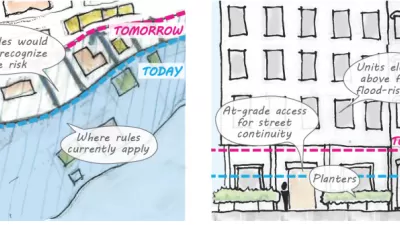Vox and Curbed provide multi-media coverage of a Staten Island sea wall project as an example of the necessity of resilient infrastructure, and the shortcomings of our ability to predict the needs of the built environments in changed climates.
Sister sites Vox and Curbed teamed up for a video and news article collaboration on the subject of New York City's plans to protect Staten Island from sea level rise and climate change by building a massive barrier.
According to the original article, written by Nathan Kensinger for Curbed, the South Shore of Staten Island Coastal Storm Risk Management Project would build a 5.3-mile long barrier from Fort Wadsworth to Oakwood Beach. "The United States Army Corps of Engineers (USACE) is now planning to break ground on this $615 million project in 2020, and expects it to be finished in approximately four years," according to Kensinger.
The project is "staggering in scope," according to Kensinger: "It will include a 4.3-mile seawall with a public promenade built on top, one mile of levees and floodwalls, and more than 180 acres of newly excavated stormwater detention ponds. The project encompasses an area with over 30,000 residents and 7,300 structures, and will protect some of the coastal neighborhoods that suffered the worst damage during Hurricane Sandy, including Arrochar, South Beach, Ocean Breeze, Graham Beach, Midland Beach, New Dorp Beach, and Oakwood Beach."
Kensinger's longread coverage of the project ranges from accounts of the devastation from Superstorm Sandy to the other big sea-level rise resilience projects in the works around New York, such as the East Side Coastal Resiliency Project, which would protect a stretch of Manhattan coastline. The article is also thoroughly supplemented with illustrative photographic examples of damage from Sandy and the locations that are bound to be transformed by future resilience efforts.
The video featured above puts Staten Island's approach to sea-level rise in context of larger thinking about resilience in the face of climate change.
FULL STORY: On Staten Island, a massive barrier will rise to protect against climate change

Planetizen Federal Action Tracker
A weekly monitor of how Trump’s orders and actions are impacting planners and planning in America.

San Francisco's School District Spent $105M To Build Affordable Housing for Teachers — And That's Just the Beginning
SFUSD joins a growing list of school districts using their land holdings to address housing affordability challenges faced by their own employees.

The Tiny, Adorable $7,000 Car Turning Japan Onto EVs
The single seat Mibot charges from a regular plug as quickly as an iPad, and is about half the price of an average EV.

Seattle's Plan for Adopting Driverless Cars
Equity, safety, accessibility and affordability are front of mind as the city prepares for robotaxis and other autonomous vehicles.

As Trump Phases Out FEMA, Is It Time to Flee the Floodplains?
With less federal funding available for disaster relief efforts, the need to relocate at-risk communities is more urgent than ever.

With Protected Lanes, 460% More People Commute by Bike
For those needing more ammo, more data proving what we already knew is here.
Urban Design for Planners 1: Software Tools
This six-course series explores essential urban design concepts using open source software and equips planners with the tools they need to participate fully in the urban design process.
Planning for Universal Design
Learn the tools for implementing Universal Design in planning regulations.
Smith Gee Studio
City of Charlotte
City of Camden Redevelopment Agency
City of Astoria
Transportation Research & Education Center (TREC) at Portland State University
US High Speed Rail Association
City of Camden Redevelopment Agency
Municipality of Princeton (NJ)





























